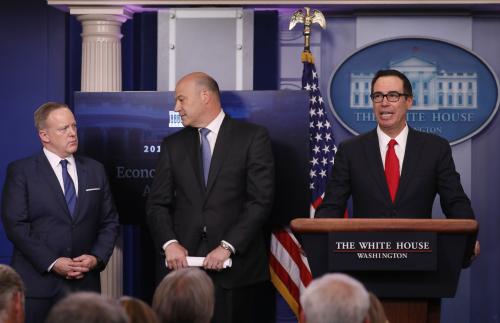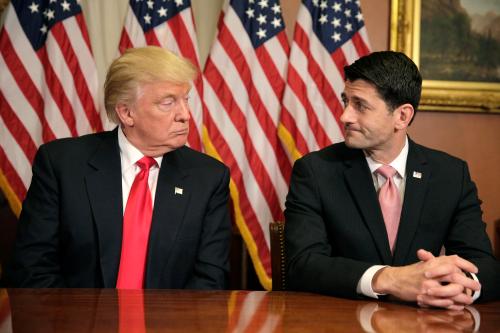This article originally appeared in Fortune on April 27, 2017.
You’ve heard it a hundred times: the U.S. corporate tax rate is the highest in the world and needs to be reduced. The problem, as President Trump is about to learn in his pursuit of a 15% business rate, is that it’s really hard to do. By targeting a rate that’s unrealistically low, he is running into a quagmire that will make the repeal of Obamacare seem simple by comparison. Here are four reasons why:
First, the rate cut would produce at least $3 trillion in losses over 10 years. Offsetting that by closing business-sector “loopholes” won’t work. It’s not just that there aren’t enough “loopholes” to pay for cuts that deep, but that the so-called loopholes are mostly tax breaks that encourage domestic investment and production. Wiping them out would slow U.S. economic growth. Making the tax cuts temporary would also reduce any pro-growth effects, because businesses would be left without a clear view of how their long-term investments will be taxed. Dynamic scoring will not make this problem go away—and could even hurt—especially if the cuts add substantially to the deficit and threaten to raise long-term interest rates.
Second, any gains to the U.S. economy by encouraging multinational corporations to do business here would be offset in part or whole by new economic inefficiencies at home. Cutting the business tax rate to 15%—well below the top individual rate—will encourage a reorganization of economic activity into pass-through businesses to qualify for the low rate. Married couples with incomes as low as $75,000 could benefit from incorporating and selling “labor services” back to their current employer. There’s no coherent way to police the line between profits and wages in small business to discourage this kind of tax avoidance. Efforts to do so with rules and regulations have not worked in the past, make the system complex, and would require intrusive IRS audits whose purpose was to tell business owners how much to pay themselves.
Cutting the business tax rate to 15%—well below the top individual rate—will encourage a reorganization of economic activity into pass-through businesses to qualify for the low rate.
Third, the unintended consequences of encouraging employees to become ‘small businesses’ are far reaching. For instance, workers earn wages, which are subject to the payroll taxes that fund Social Security and Medicare, but much of the business income earned by pass-throughs is not. In effect, these new business owners will have the option to opt out of contributing to Social Security and Medicare, as many already do. And since employees are offered a wide range of insurance and retirement benefits and labor and safety protections that often do not apply to business owners, this change is likely to have implications that extend far beyond the tax code.
Fourth, the tax cut would be extremely regressive. Nearly all of the benefits of cutting the business rate to 15% would be reaped by those in the top 1%. That outcome is hard to avoid when the top 1% earn about 70% of all pass-through income from partnerships and S-corporations, while the bottom two-thirds of pass-through owners would not benefit because they already face rates of 15% or less.
We may wish for the lower corporate tax rates that other countries have adopted, but we seem unwilling to consider why such rates are viable for them but not for us. Countries with low corporate rates generally have large border-adjusted consumption taxes (value added taxes, which tax business owners on their profits), high shareholder taxes (high dividend and capital gains taxes), few opportunities to shelter investment income in pensions, retirement accounts, or by endowments, or charities, and requirements that limit pass-through businesses or impose corporate taxes broadly. In other words, these countries achieve low corporate rates only by imposing high rates on owners, both when the income is earned and when it is consumed. Our tax system is quite different. Here, the high business tax rate is the backstop that props up the individual and payroll tax systems, which jointly further a variety of economic, equity, and revenue goals.
If Trump wants a 15% corporate rate, he can consider solutions used elsewhere, like imposing new consumption taxes or raising taxes on shareholders—including those currently exempt from tax. In the meantime, Americans should get comfortable having a high business rate.







Commentary
Op-ed4 reasons Trump’s tax plan is a tougher sell than Trumpcare
April 27, 2017